Lyons W.C. (ed.). Standard handbook of petroleum and natural gas engineering.2001- Volume 1
Подождите немного. Документ загружается.

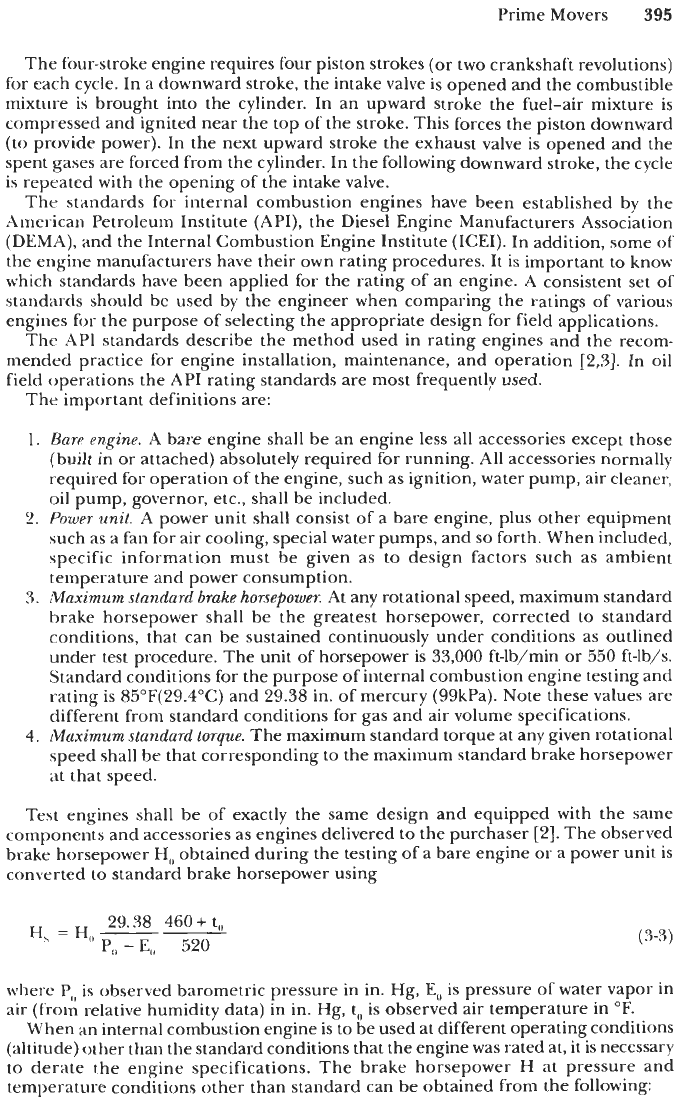
Prime Movers
395
The four-stroke engine requires four piston strokes (or two crankshaft revolutions)
for
each cycle. In a downward stroke, the intake valve is opened and the combustible
mixture is brought into the cylinder. In an upward stroke the fuel-air mixture is
compressed and ignited near the top of the stroke. This forces the piston downward
(to provide power). In the next upward stroke the exhaust valve is opened
and
the
spent gases are forced from the cylinder. In the following downward stroke, the cycle
is repeated with the opening of the intake valve.
The standards for internal combustion engines have been established by the
American Petroleum Institute (API), the Diesel Engine Manufacturers Association
(DEMA), and the Internal Combustion Engine Institute (ICEI). In addition, some
of
the engine manufacturers have their own rating procedures.
It
is
important to know
which standards have been applied for the rating of an engine. A consistent set of
standards should be used by the engineer when comparing the ratings of various
engines for the purpose of selecting the appropriate design
for
field applications.
The API standards describe the method used in rating engines and the recom-
mended practice for engine installation, maintenance, and operation
[2,3].
In oil
field operations the API rating standards are most frequently used.
The important definitions are:
1.
Bare
engine.
A
bare engine shall be an engine less all accessories except those
(built in or attached) absolutely required for running. All accessories normally
required for operation
of
the engine, such as ignition, water pump, air cleaner,
oil pump, governor, etc., shall be included.
2.
Power unit.
A
power unit shall consist
of
a bare engine, plus other equipment
such as a fan for air cooling, special water pumps, and
so
forth. When included,
specific information must be given as
to
design factors such as ambient
temperature and power consumption.
3.
Maximum standard brake horsepower.
At
any rotational speed, maximum standard
brake horsepower shall be the greatest horsepower, corrected to standard
conditions, that can be sustained continuously under conditions as outlined
under test procedure. The unit of horsepower is 33,000 ft-lb/min or
550
ft-lb/s.
Standard conditions for the purpose of internal combustion engine testing and
rating is
85"F(29.4"C)
and 29.38 in. of mercury (99kPa). Note these values are
different from standard conditions for gas and air volume specifications.
4.
Maximum standard torque.
The maximum standard torque at any given rotational
speed shall be that corresponding
to
the maximum standard brake horsepower
at that speed.
Test engines shall be of exactly the same design and equipped with the same
components and accessories as engines delivered to the purchaser
[2].
The observed
brake horsepower
H,,
obtained during the testing of a bare engine or a power unit
is
converted
to
standard brake horsepower using
29.38
460
+
t,,
H,
=
H,,
-~
P,,
-E,,
520
(3-3)
wherc
P,,
is
observed barometric pressure in in. Hg,
E,,
is pressure of water
Vapor
in
air (from relative humidity data) in in.
Hg,
t,,
is observed air temperature in
OF.
When an internal combustion engine
is
to be used at different operating conditions
(altitude) other than the standard conditions that the engine was rated at, it is necessary
to derate the engine specifications. The brake horsepower
H
at pressure and
temperature conditions other than standard can be obtained from the following:
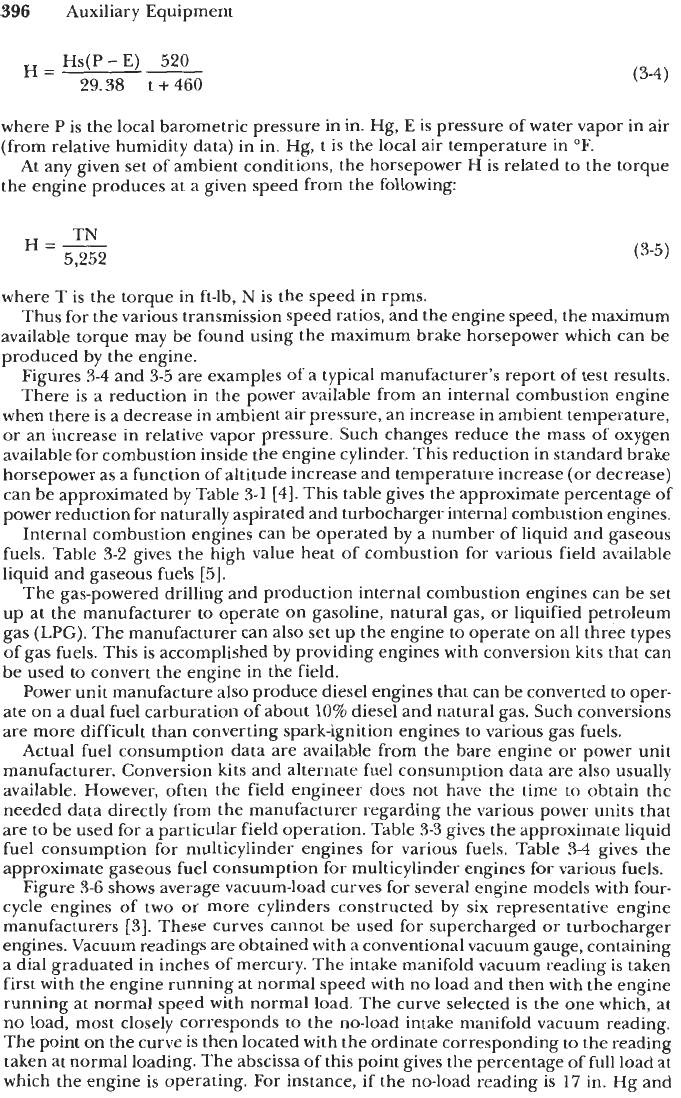
396
Auxiliary Equipment
Hs(P-E)
520
H=
29.38
t
+
460
(3-4)
where
P
is the local barometric pressure in in. Hg, E is pressure of water vapor in air
(from relative humidity data) in in. Hg,
t
is
the local air temperature in
OF.
At any given set of ambient conditions, the horsepower
H
is related to the torque
the engine produces at a given speed from the following:
TN
H=-
5,252
(5-5)
where T
is
the torque in ft-lb,
N
is
the speed in rpms.
Thus for the various transmission speed ratios, and the engine speed, the maximum
available torque may be found using the maximum brake horsepower which can be
produced by the engine.
Figures
3-4
and
3-5
are examples of
a
typical manufacturer’s report of test results.
There is a reduction in the power available from an internal combustion engine
when there is a decrease in ambient air pressure, an increase in ambient temperature,
or an increase in relative vapor pressure. Such changes reduce the mass of oxygen
available for combustion inside the engine cylinder. This reduction in standard brake
horsepower as a function of altitude increase and temperature increase (or decrease)
can
be
approximated
by
Table
3-1
[4].
This table gives the approximate percentage of
power reduction for naturally aspirated and turbocharger internal combustion engines.
Internal combustion engines can be operated by a number of liquid and gaseous
fuels. Table
3-2
gives the high value heat of combustion for various field available
liquid and gaseous fuels
[5].
The gas-powered drilling and production internal combustion engines can be set
up at the manufacturer
to
operate on gasoline, natural gas, or liquified petroleum
gas (LPG). The manufacturer can also set up the engine
to
operate on all three types
of gas fuels. This is accomplished by providing engines with conversion
kits
that can
be used to convert the engine in the field.
Power unit manufacture also produce diesel engines that can be converted to oper-
ate on a dual fuel carburation of about
10%
diesel and natural gas. Such conversions
are more difficult than converting spark-ignition engines to various gas fuels.
Actual fuel consumption data are available from the bare engine or power unit
manufacturer. Conversion kits and alternate fuel consumption data are also usually
available. However, often the field engineer does not have the time to obtain the
needed data directly from the manufacturer regarding the various power units that
are to be used for a particular field operation. Table
3-3
gives the approximate liquid
fuel consumption for multicylinder engines for various fuels. Table
34
gives the
approximate gaseous fuel consumption for multicylinder engines for various fuels.
Figure
3-6
shows average vacuum-load curves for several engine models with four-
cycle engines of two or more cylinders constructed by six representative engine
manufacturers
[3].
These curves cannot be used for supercharged or turbocharger
engines. Vacuum readings are obtained with a conventional vacuum gauge, containing
a dial graduated in inches of mercury. The intake manifold vacuum reading is taken
first with the engine running at normal speed with no load and then with the engine
running at normal speed with normal load. The curve selected
is
the one which, at
no
load, most closely corresponds to the no-load intake manifold vacuum reading.
The point on the curve is then located with the ordinate corresponding to the reading
taken at normal loading. The abscissa
of
this point gives the percentage of full load at
which the engine is operating. For instance,
if
the no-load reading is
17
in. Hg and
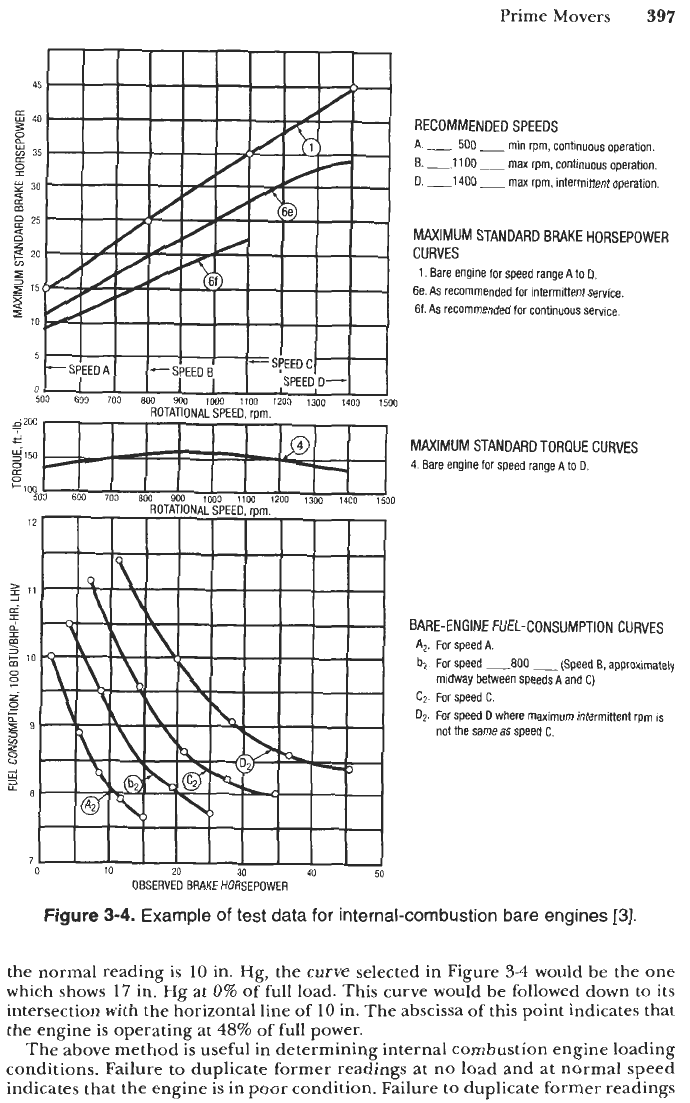
Prime Movers
397
RECOMMENDED SPEEDS
A.
I
500
-
min rpm, continuous operation.
6.
-1
100
-
max rpm. continuous operation.
D.
-1400
-
max
rpm, intermittent operation
MAXIMUM
STANDARD
BRAKE
HORSEPOWER
CURVES
1.
Bare engine for speed range
A
to
0.
6e.
As
recommended for intermittent service.
6f.
As recommended for continuous service.
MAXIMUM STANDARD TORQUE CURVES
4
Bare engine for
speed
range
A
to
D.
BARE-ENGINE FUEL-CONSUMPTION CURVES
Ap. For speed
A.
bl.
For speed
-800
-(Speed 6. approximately
C2.
For
speed
C.
D2.
For
speed
D
where
maximum intermittent rpm
is
midway
between
speeds
A
and
C)
not
the
same as
SDWd
C.
OBSERVED BRAKE HORSEPOWER
Figure
3-4.
Example
of
test data
for
internal-combustion bare engines
[3].
the normal reading
is
10
in. Hg, the curve selected in Figure
3-4
would be the one
which shows
17
in. Hg at
0% of
full load. This curve would be followed down
to
its
intersection with the horizontal line of
10
in. The abscissa
of
this point indicates that
the engine is operating at
48%
of full power.
The above method
is
useful in determining internal combustion engine loading
conditions. Failure
to
duplicate former readings at no load and at normal speed
indicates that the engine is in poor condition. Failure to duplicate former readings
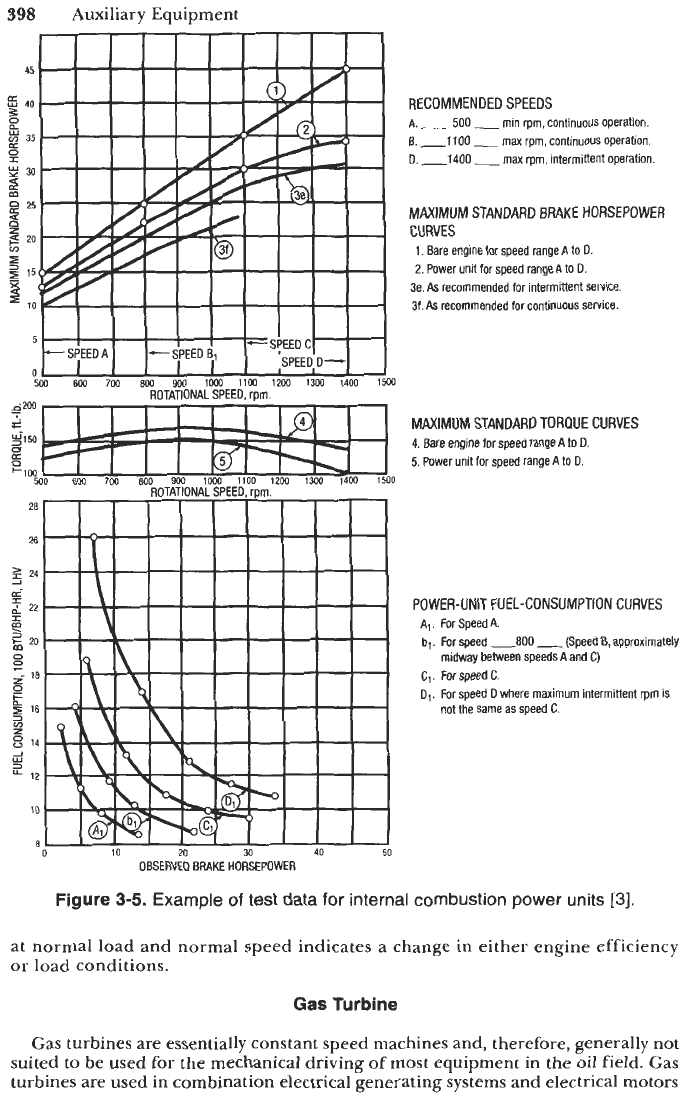
198
Auxiliary Equipment
RECOMMENDED SPEEDS
A.
-
500
-
min rpm, continuous operation.
E.
-1100
-
max
rpm,
continuous
operation.
D.-1400
-
max rpm, intermittent operation.
MAXIMUM STANDARD BRAKE HORSEPOWER
CURVES
1.
Bare engine for speed range
A
to
D.
2.
Power unit for speed range
A
to
D.
3e.As recommended for
intermittent
service.
3f.
As
recommended for
continuous
sewice.
MAXIMUM STANDARD TORQUE CURVES
4.
Bare
engine
for
speed
rangeA
to
D.
5.
Power
unit
for speed range A to
0.
POWER-UNIT FUEL-CONSUMPTION CURVES
A,.
For Speed
A.
bl.
For
speed
-800
-(Speed B, amximately
C,.
For
speed
C.
D,.
For
speed
D
where
maximum
intermittent rpm
is
midway between speeds A and
C)
not
the
same
as
weed
C.
OBSERVED BRAKE
HORSEPOWER
Figure
3-5.
Example
of
test data
for
internal combustion power units
131.
at normal load and normal speed indicates a change in either engine efficiency
or load conditions.
Gas
Turbine
Gas turbines are essentially constant speed machines and, therefore, generally not
suited
to
be used for the mechanical driving
of
most equipment in the oil field. Gas
turbines are used in combination electrical generating systems and electrical motors
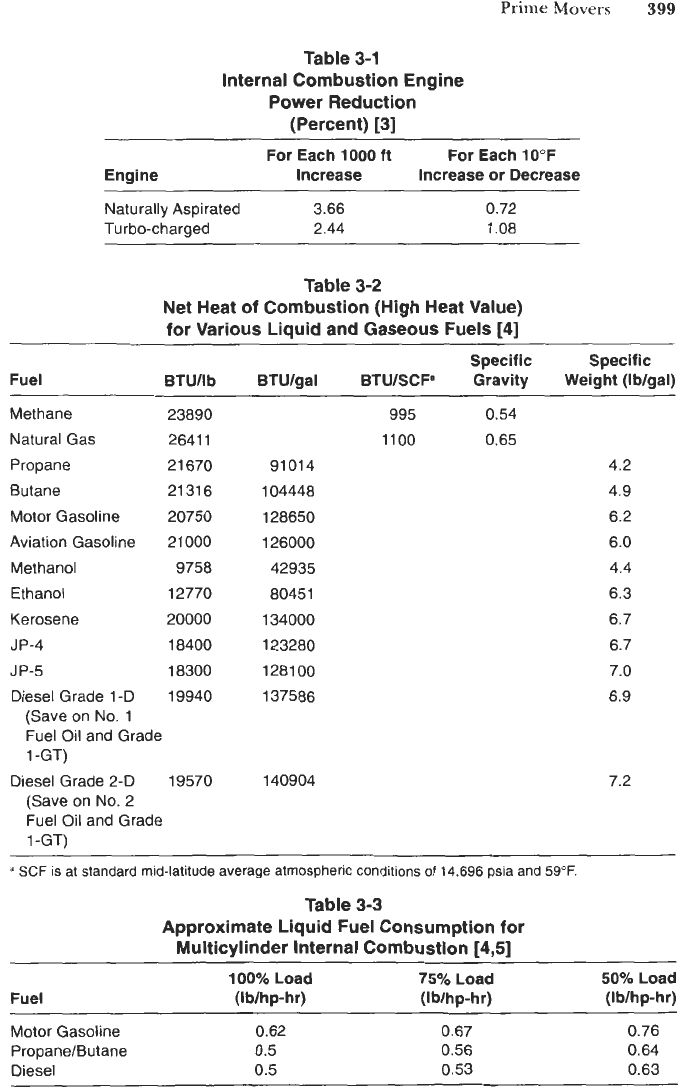
Prime
Movers
399
Table
3-1
Internal Combustion Engine
Power Reduction
(Percent)
[3]
For Each
1000
ft
For Each
10°F
Engine Increase Increase or Decrease
~~~~
~
Naturally Aspirated
3.66 0.72
Turbo-charged
2.44 1.08
Table
3-2
Net Heat of Combustion
(High
Heat Value)
for Various Liquid and Gaseous Fuels
[4]
Fuel BTUllb BTU/gal BTU/SCFa Gravity Weight (Iblgal)
Specific Specific
Methane
Natural Gas
Propane
Butane
Motor Gasoline
Aviation Gasoline
Methanol
Ethanol
Kerosene
JP-4
JP-5
Diesel Grade
1
-D
(Save
on
No.
1
23890
2641 1
21670
21316
20750
21000
9758
12770
20000
18400
18300
19940
Fuel
Oil
and Grade
1
-GT)
Diesel Grade
2-D 19570
(Save
on
No.
2
Fuel Oil and Grade
1
-GT)
91014
104448
128650
126000
42935
80451
134000
123280
128100
137586
140904
995
0.54
1100 0.65
4.2
4.9
6.2
6.0
4.4
6.3
6.7
6.7
7.0
6.9
7.2
a
SCF
is at standard mid-latitude average atmospheric conditions
of 14.696
psia
and
59°F.
Table
3-3
Approximate Liquid Fuel Consumption for
Multicylinder internal Combustion
[4,5]
~~~
50%
Load
100%
Load
75%
Load
Fuel
(Iblhp-hr)
(Iblhp-hr)
(1MP-W
Motor Gasoline
0.62 0.67 0.76
PropanelButane
0.5
0.56 0.64
Diesel
0.5 0.53 0.63
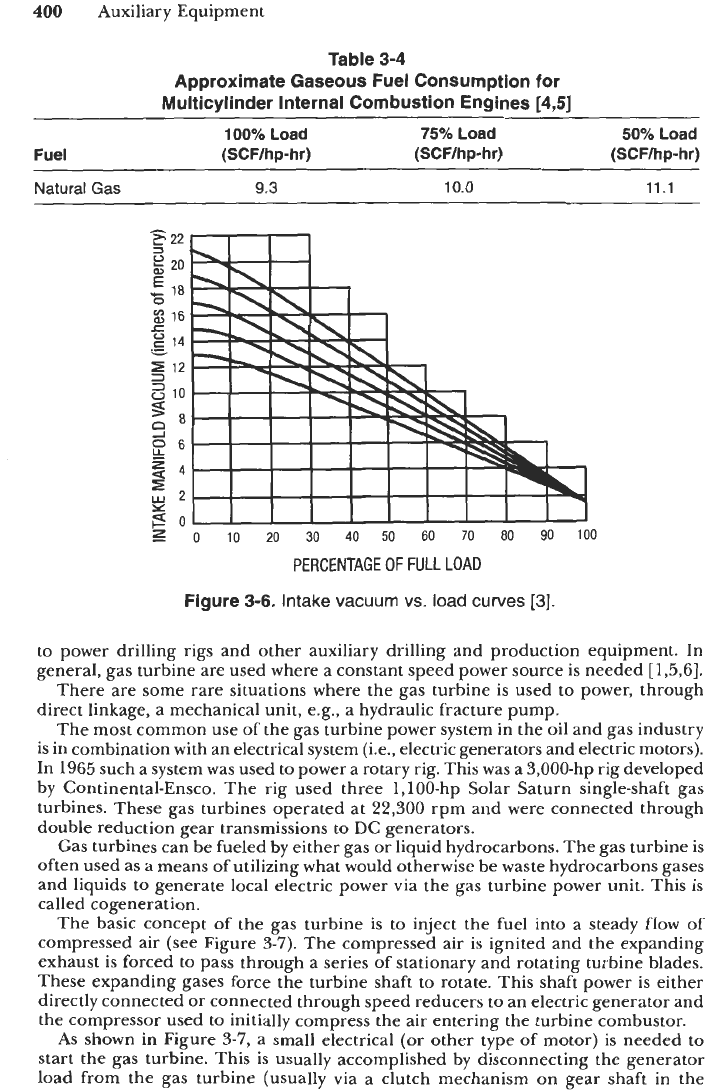
400
Auxiliary Equipment
Table
3-4
Approximate Gaseous Fuel Consumption
for
Multicylinder Internal Combustion Engines
[4,5]
100%
Load 75% Load
50%
Load
Fuel (SCFlhp-hr) (SCF/hp-hr) (SCFlhp-hr)
Natural
Gas
9.3
10.0
11.1
,-
0
10
20
30
40
50
60
70
80 90
100
PERCENTAGE
OF
FULL
LOAD
Figure
3-6.
Intake
vacuum
vs.
load
curves
[3].
to power drilling rigs and other auxiliary drilling and production equipment. In
general, gas turbine are used where a constant speed power source is needed [1,5,6].
There are some rare situations where the gas turbine is used to power, through
direct linkage, a mechanical unit, e.g., a hydraulic fracture pump.
The most common use of the gas turbine power system in the oil and gas industry
is in combination with
an
electrical system (i.e., electric generators and electric motors).
In 1965 such a system was used to power a rotary rig. This was a 3,000-hp rig developed
by Continental-Ensco. The rig used three 1,100-hp Solar Saturn single-shaft gas
turbines. These gas turbines operated at
22,300
rpm and were connected through
double reduction gear transmissions to
DC
generators.
Gas turbines
can
be fueled by either gas or liquid hydrocarbons. The gas turbine is
often used as a means of utilizing what would otherwise be waste hydrocarbons gases
and liquids to generate local electric power via the gas turbine power unit. This is
called cogeneration.
The basic concept of the gas turbine is to inject the fuel into a steady flow
of
compressed air (see Figure
3-7).
The compressed air is ignited and the expanding
exhaust is forced to pass through a series
of
stationary and rotating turbine blades.
These expanding gases force the turbine shaft to rotate. This shaft power is either
directly connected
or
connected through speed reducers
to
an electric generator and
the compressor used
to
initially compress the air entering the turbine combustor.
As
shown in Figure
3-7,
a small electrical (or other type of motor) is needed to
start the gas turbine. This is usually accomplished by disconnecting the generator
load from the gas turbine (usually via a clutch mechanism on gear shaft in the
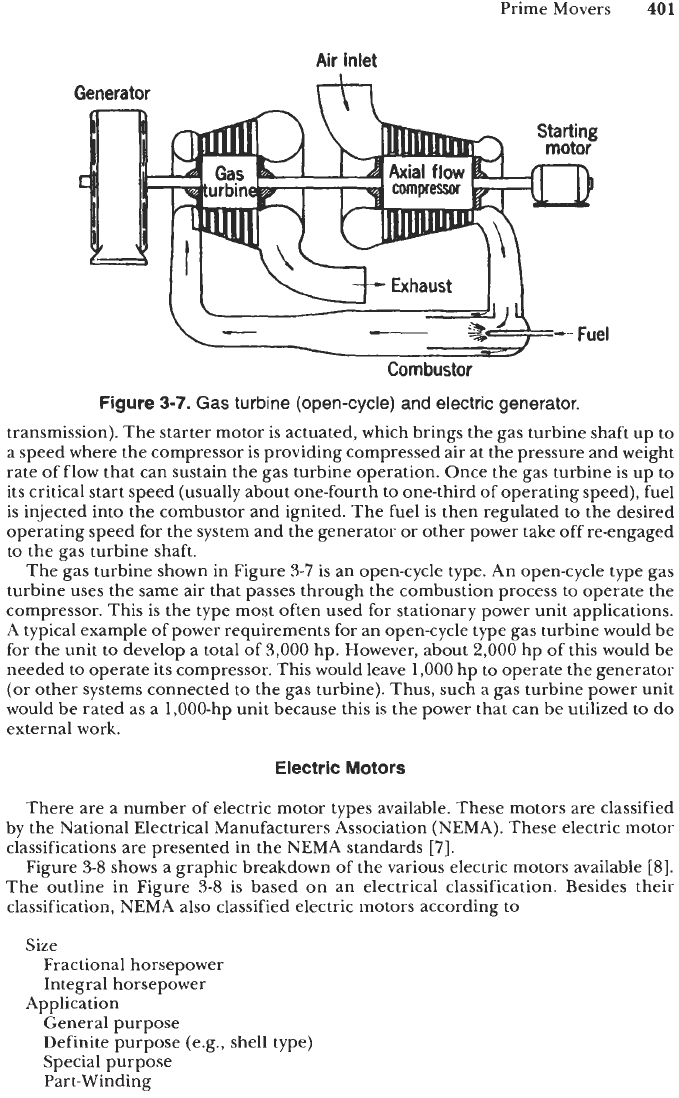
Prime Movers
401
Generator
fk
--
Fuel
Com
bustor
Starting
motor
Figure
3-7.
Gas turbine (open-cycle) and electric generator.
transmission). The starter motor is actuated, which brings the gas turbine shaft up to
a speed where the compressor is providing compressed air at the pressure and weight
rate of flow that can sustain the
gas
turbine operation. Once the gas turbine
is
up
to
its critical start speed (usually about one-fourth to one-third
of
operating speed), fuel
is injected into the combustor and ignited. The fuel is then regulated to the desired
operating speed for the system and the generator or other power take off re-engaged
to the gas turbine shaft.
The gas turbine shown in Figure
3-7
is an open-cycle type. An open-cycle type gas
turbine uses the same air that passes through the combustion process to operate the
compressor. This is the type most often used for stationary power unit applications.
A typical example
of
power requirements for an open-cycle type gas turbine would be
for the unit to develop a total of
3,000
hp. However, about
2,000
hp of this would be
needed to operate its compressor. This would leave
1,000
hp to operate the generator
(or other systems connected to the gas turbine). Thus, such
a
gas turbine power unit
would be rated as a 1,000-hp unit because this is the power that can be utilized to do
external work.
Electric
Motors
There are a number of electric motor types available. These motors are classified
by the National Electrical Manufacturers Association
(NEMA).
These electric motor
classifications are presented in the NEMA standards
[7].
Figure
3-8
shows a graphic breakdown of the various electric motors available
[8].
The outline in Figure
3-8
is based on an electrical classification. Besides their
classification, NEMA also classified electric motors according
to
Size
Fractional horsepower
Integral horsepower
General purpose
Definite purpose (e.g., shell type)
Special purpose
Part-Winding
Application
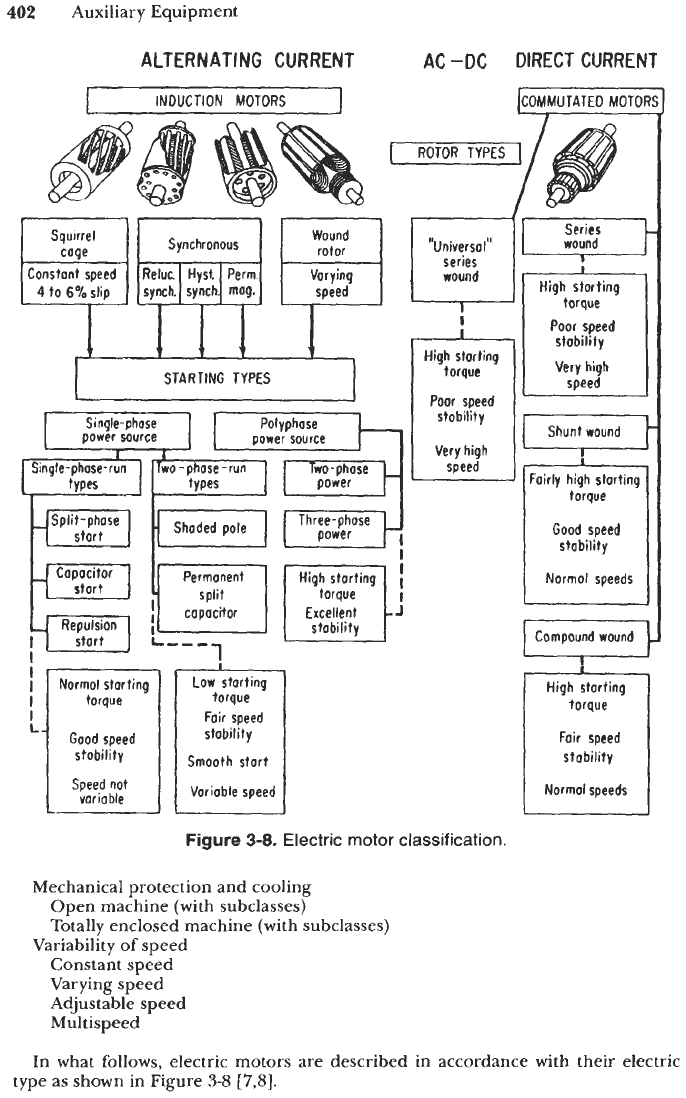
402
Auxiliary Equipment
ALTERNATING CURRENT
AC
-DC DIRECT CURRENT
INDUCTION
MOTORS
I
COMMUTATED MOTORS
STARTING
TYPES
toroue
'1
Good speed
stobility
Speed not
vorioble
1
torque
Foir speed
stability
Smooth stort
Vorioble
speed
torque
Foir
speed
stobility
Normol speeds
Figure
3-8.
Electric
motor
classification.
Mechanical protection and cooling
Open machine (with subclasses)
Totally enclosed machine (with subclasses)
Variability
of
speed
Constant speed
Varying speed
Adjustable speed
Mu1
tispeed
In what follows, electric motors are described in accordance with their electric
type as shown in Figure
3-8
[7,8].
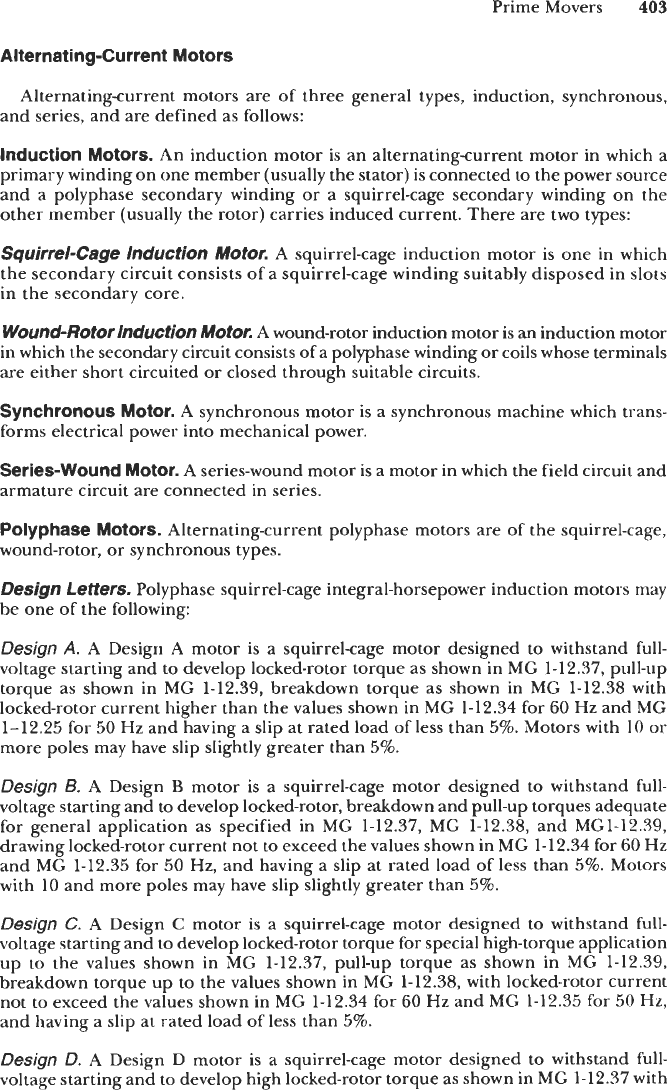
Prime Movers
403
Alternating-Current Motors
Alternating-current motors are of three general types, induction, synchronous,
and series. and are defined as follows:
lnduction Motors.
An induction motor is an alternating-current motor in which a
primary winding on one member (usually the stator) is connected to the power source
and a polyphase secondary winding
or
a squirrel-cage secondary winding on the
other member (usually the rotor) carries induced current. There are two types:
Squirrel-Cage lnduction Motor.
A
squirrel-cage induction motor is one in which
the secondary circuit consists of a squirrel-cage winding suitably disposed in slots
in
the secondary core.
Woun&Rotor
induction
Motor.
A wound-rotor induction motor is
an
induction motor
in which the secondary circuit consists of a polyphase winding or coils whose terminals
are either short circuited or closed through suitable circuits.
Synchronous Motor.
A
synchronous motor is a synchronous machine which trans-
forms electrical power into mechanical power.
Series-wound Motor.
A
series-wound motor is a motor in which the field circuit and
armature circuit are connected in series.
Polyphase Motors.
Alternating-current polyphase motors are
of
the squirrel-cage,
wound-rotor, or synchronous types.
Design Letters.
Polyphase squirrel-cage integral-horsepower induction motors may
be one
of
the following:
Design
A.
A
Design
A
motor is a squirrel-cage motor designed to withstand full-
voltage starting and to develop locked-rotor torque as shown in
MG
1-12.37,
pull-up
torque as shown in
MG
1-12.39,
breakdown torque as shown in
MG
1-12.38
with
locked-rotor current higher than the values shown in MG
1-12.34
for
60
Hz
and MG
1-12.25
for
50
Hz
and having a slip at rated load of less than
5%.
Motors with
10
or
more poles may have slip slightly greater than
5%.
Design
6.
A Design
€3
motor is a squirrel-cage motor designed
to
withstand full-
voltage starting and
to
develop locked-rotor, breakdown and pull-up torques adequate
for general application as specified in MG
1-12.37,
MG
1-12.38,
and
MG1-12.39,
drawing locked-rotor current not to exceed the values shown in MG
1-12.34
for
60
Hz
and MG
1-12.35
for
50
Hz,
and having a slip at rated load of less than
5%.
Motors
with
10
and more poles may have slip slightly greater than
5%.
Design
C.
A
Design
C
motor
is
a squirrel-cage motor designed to withstand full-
voltage starting and to develop locked-rotor torque for special high-torque application
up to the values shown in
MG
1-12.37,
pull-up torque as shown in MG
1-12.39,
breakdown torque
up
to the values shown in MG
1-12.38,
with locked-rotor current
not to exceed the values shown in MG
1-12.34
for
60
Hz
and MG
1-12.35
for
50
Hz,
and having a slip at rated load
of
less than
5%.
Design D. A
Design
D
motor is a squirrel-cage motor designed to withstand full-
voltage starting and to develop high locked-rotor torque as shown in MG
1-12.37
with
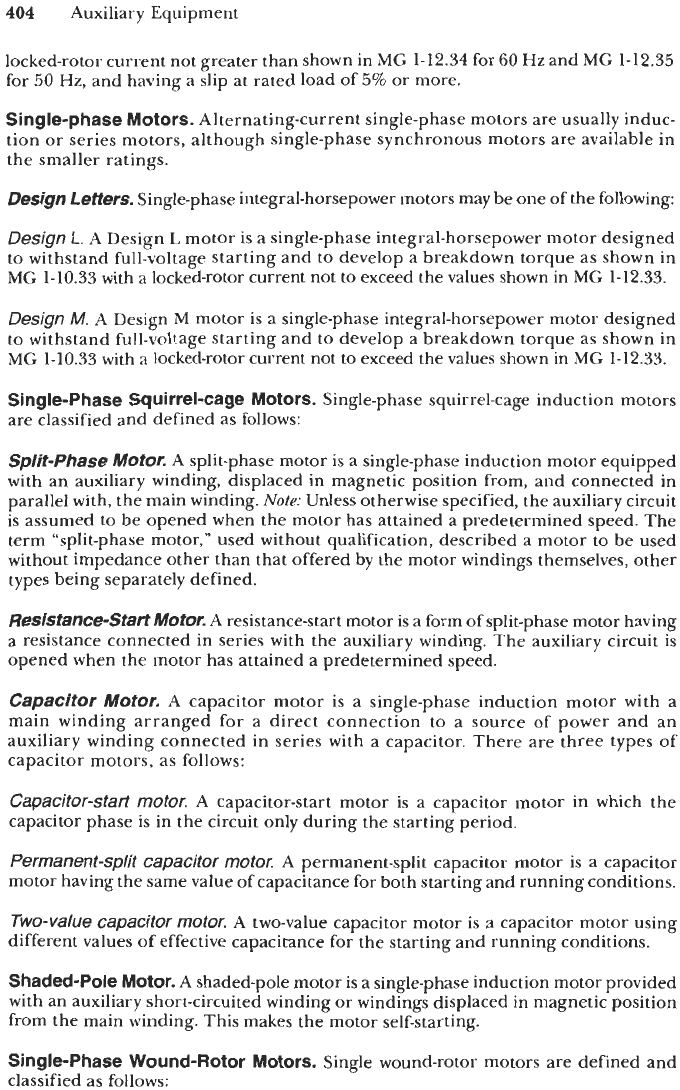
404
Auxiliary Equipment
locked-rotor current not greater than shown in MG
1-12.34
for
60
Hz
and MG
1-12.35
for
50
Hz,
and having a slip at rated load
of
5%
or
more.
Single-phase Motors.
Alternating-current single-phase motors are usually induc-
tion
or
series motors, although single-phase synchronous motors are available in
the smaller ratings.
Design Leffers.
Single-phase integral-horsepower motors may be one of the following:
Design
L.
A
Design L motor is a single-phase integral-horsepower motor designed
to
withstand full-voltage starting and to develop a breakdown torque as shown in
MG
1-10.33
with a locked-rotor current not to exceed the values shown in MG
1-12.33.
Design
M.
A
Design
M
motor is a single-phase integral-horsepower motor designed
to withstand full-voltage starting and to develop a breakdown torque as shown in
MG
1-10.33
with a locked-rotor current not to exceed the values shown in MG
1-12.33.
Single-phase Squirrel-cage Motors.
Single-phase squirrel-cage induction motors
are classified and defined as follows:
Split-Phase Motor.
A split-phase motor is a single-phase induction motor equipped
with an auxiliary winding, displaced in magnetic position from, and connected in
parallel with, the main winding.
Note:
Unless otherwise specified, the auxiliary circuit
is assumed to be opened when the motor has attained a predetermined speed. The
term "split-phase motor," used without qualification, described a motor to be used
without impedance other than that offered by the motor windings themselves, other
types being separately defined.
Resistance-Start Motor.
A
resistance-start motor is a form of split-phase motor having
a resistance connected in series with the auxiliary winding. The auxiliary circuit
is
opened when the motor has attained a predetermined speed.
Capacitor Motor.
A capacitor motor
is
a
single-phase induction motor with a
main winding arranged for a direct connection to a source of power and an
auxiliary winding connected in series with a capacitor. There are three types
of
capacitor motors, as follows:
Capacitor-start motor.
A capacitor-start motor is a capacitor motor in which the
capacitor phase is in the circuit only during the starting period.
Permanent-split capacitor motor.
A
permanent-split capacitor motor is a capacitor
motor having the same value of capacitance for both starting and running conditions.
Two-value capacitor motOK
A two-value capacitor motor is a capacitor motor using
different values of effective capacitance for the starting and running conditions.
Shaded-Pole Motor.
A shaded-pole motor is a single-phase induction motor provided
with an auxiliary short-circuited winding or windings displaced in magnetic position
from the main winding. This makes the motor self-starting.
Single-phase Wound-Rotor Motors.
Single wound-rotor motors are defined and
classified as follows:
